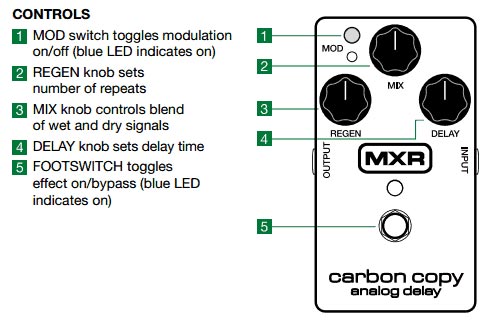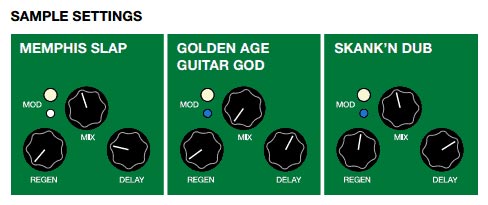The MXR M169 Carbon Copy is a 100% analog pedal that not only creates a great sounding analog tone, but it also has a couple interesting features to give you tone an extra tweak you might not expect in a delay pedal. If you’re looking for a simple delay pedal with a great reputation and excellent quality, continue reading.
Carbon Copy Features
Here are the main features of the Carbon Copy:
100% analog bucket-brigade technology
You probably have heard the term analog used over an over again and know what it means. But you may not have heard of ‘bucket-brigade’ technology before. It’s an interesting way to explain how the delay circuitry works. It’s based on how firemen used to put out fires back before hoses were available. There would be a line of firemen and they would literally pass a bucket full of water from one person to the next until it reached the person at the fire.
As you can imagine, as the bucket is passed from person to person, there would be a bit of spillage so by the end of the line the bucket wouldn’t be full anymore. So now instead of water imagine the bucket contain your guitar signal and instead of a line of people passing the bucket around, you have a chain of capacitors. You play a note and that note is carried down the line of capacitors. Gradually your tone will ‘spill’ every time it is stored in a capacitor which in the real world means that you lose some high frequency (your tone becomes muddier or darker).
If you increase the delay time, the capacitors need to store your signal for longer, which leads to more spillage. So depending on how long the delay is set for or how many repeats you set, you could have a very dark sound without any high frequencies.
Keep the above explanation in mind when you adjust your delay and regen knobs because it will help you understand how your settings will affect the tone of the delayed signal. The main thing to remember with this feature is that the delayed sound isn’t an exact copy of your original guitar parts – they will be altered by this ‘bucket-brigade’ circuitry.
Up to 600ms of delay
If you have used digital delay pedals before, this number might seem low. But remember that this is an analog pedal so there is a limitation to how long the pedal can hold onto your signal in it’s circuitry. In practical terms, 600ms is equivalent to quarter notes at 100bpm or eighth notes at 50bpm. So for most songs, this is plenty of delay time. There will be very few times when you will genuinely need delay with a longer time than 600ms. But of course, this depends on what style you play and what you want out of your delay pedal.
Modulation
On the top right area of the pedal is a ‘MOD’ button which switches on a modulation effect. This effect adds more ‘body’ and depth to your tone and can really change the way you sound. The width and speed of this modulation effect can be controlled by adjusting two trim pots internally. This effect sounds very similar to chorus but of course, this depends on the settings you set for it.
True Bypass
When the delay is turned off, the pedal switches to a True Bypass mode. As the Carbon Copy is a 100% analog pedal, this is expected. Read this guide to find out what True Bypass means.
Ease of use
There are three main knobs to control the delay on the Carbon Copy. That’s really all you need for any delay unless you add in other effects so the Carbon Copy is very easy to use. The REGEN knob sets how many times your delay will repeat. The MIX knob adjusts the wet/dry balance. If you’re not sure what that means it adjusts the volume of the delay signal and mixes it with your original guitar signal. So you can turn down the delay or turn it up to the level you want. The DELAY knob adjusts the time delay before the repeated signal sounds. Remember that the maximum delay is 600ms (which is 0.6 seconds) so if you turn the knob all the way to the right 600ms will be the maximum setting.

While the three knobs make it an easy job to set up your basic delay settings, the MOD is a little tricky to set up. You need to physically remove the back casing of the pedal to access the two trim pots that control the modulation’s width and speed. Be careful when adjusting the trim pots because they’re not as sturdy as the three main knobs. This also means you cannot easily adjust the modulation effect without having to open the pedal up. This isn’t too much of an issue because you probably set the modulation to how you like it and you will leave it at that. That’s what I did and only needed to tweak it a few times until I was happy with it.
What is more annoying is that to turn the modulation effect on and off, there is no footswitch. The tiny button cannot be pressed by your foot so you can only turn modulation on and off by bending down and using your hand. It’s a bit disappointing but in most situations, you will only need to set it once before playing a song.
There is a bright blue LED to indicate when the pedal is on and another LED to indicate if the modulation effect is on. The main LED is super bright and can be distracting in the dark. It was designed for stage use so if you only use it at home – you might find that you will need to cover it with tape to lessen the brightness.
This pedal has a single input and a single output so it’s very easy to set up. Keep in mind that some delay pedals are stereo with multiple outputs so having only one in and one out is a nice change.
Sound
The MXR Carbon Copy has an excellent reputation and is used by a lot of professional guitarists. The main reason is the sound quality. While you shouldn’t jump at a pedal just because it boasts that it’s analog, this pedal sounds great. The analog circuitry alters the tone in a way that really suits the delay effect. Losing some of the high frequencies means that your main signal will stand out above the repeated signal. The delayed signal has a darker/muddier sound and the modulation effect can really enhance your tone. Some guitarists have the pedal on constantly just to take advantage of the way the modulation enhances the tone. I do this by setting a very subtle delay and it really enhanced my tone without being distracting.

Above are a couple sample settings suggested in the Carbon Copy’s manual (it’s really an information sheet). These settings are good starting points to experiment with.
Reliability/Quality
MXR (manufactured by Dunlop) have a reputation for building pedals as strong as tanks. The Carbon Copy pedal is heavy given its small size and I would expect this to hold up to gigging easily. The three knobs are sturdy and I would be surprised if they broke unless the pedal was thrown around. The simple controls and metal construction means this pedal will last for years without problems.
Overall impression
This is a very simple delay pedal and doesn’t have many of the effects available with other delay pedals. Delay is almost an essential effect for guitarists and the Carbon Copy allows you to have the delay effect without complicating matters with effects such as ping-pong, reverse, etc. My students and I enjoy the way the Carbon Copy alters the tone and it sounds great when the modulation is turned on. Find out the price and full details of the Carbon Copy here on Amazon.
Pros
- Easy to use – simple controls
- Maximum of 600ms is plenty for most situations
- The modulation effect is a great bonus
- Strong metal construction and small size
Cons
- Modulation button isn’t accessible by foot
- Internal controls for modulation seem unnecessary
- Super bright LED will burn your retinas (not really)
Who is it for?
Gigging guitarists – having a good sounding delay can really make a difference to your live tone. This pedal provides fantastic delay that should suit most styles. If you don’t need all the different styles of delay and just need the basic effect, this pedal is highly recommended
Home recording – the quality of the analog tone here is fantastic for any recordings you plan on doing. The warmth and darkness of the delay really compliment your main tone.
Who isn’t it for?
There are so many different ways you can use delay and there are so many different types of delay available. If you want to have more control over your delay and step away from the standard effect, then the Carbon Copy may not be for you. For example here are the different types of delay available on the TC Electronic Flashback Delay Pedal: 2290, Analog, Tape, Lo-fi, Dynamic, Modulated, Ping-pong, Slapback, and Reverse. The Flashback delay also has up to 7 seconds maximum delay so this gives you an idea of the difference in flexibility between an analog and digital delay pedal. With an analog pedal like the Carbon Copy, you get a basic delay sound. With a digital pedal such as the TC Electronic Flashback (compare the Flashback pedal range here), you will have all the flexibility you will ever need. If you want flexibility, then the Carbon Copy probably isn’t for you.
How to get the most out of the Carbon Copy
- Experiment with the modulation settings. First, adjust the width trimpot and find the setting you prefer. Then adjust the speed trimpot until you’re happy with the results. Leave the back cover off for a while as you will probably want to tweak the modulation settings until you find the perfect settings that are right for you.
- Try using the delay and modulation to enhance your normal tone. Rather than using the pedal to create the standard repeating delay type sound, experiment with the settings to create a ‘thicker’ sound. To do this set the MIX and DELAY knobs low and play around with the REGEN knob. This almost creates a reverb type sound that trails off your main tone.
- Experiment with the extremes. See what happens when you crank the MIX knob right up. Then turn it back down and see what happens when you crank up the REGEN knob. Then again with the DELAY knob. This is the best way to get a feel for the Carbon Copy’s possibilities.
Alternatives to the Carbon Copy
The MXR Carbon Copy is possibly one of the best analog delay pedals available. So I’ll list a few high quality digital delay pedals you might want to consider as an alternative if flexibility is more important to you than an analog effect.
- TC Electronic Flashback Delay 2 Pedal
- Boss DD-7 Digital Delay Pedal
- Line 6 HX Effects (very impressive stompbox powerhouse that includes the popular DL4 delays)
If you’re looking to buy a delay best but aren’t sure whether this is the best one for you, check out my Buyer’s Guide on finding the Best Delay Pedal. It explains how to find the best delay pedal for your needs.
See information on pricing, availability and other reviews here.
Related Guides and Lessons:

























